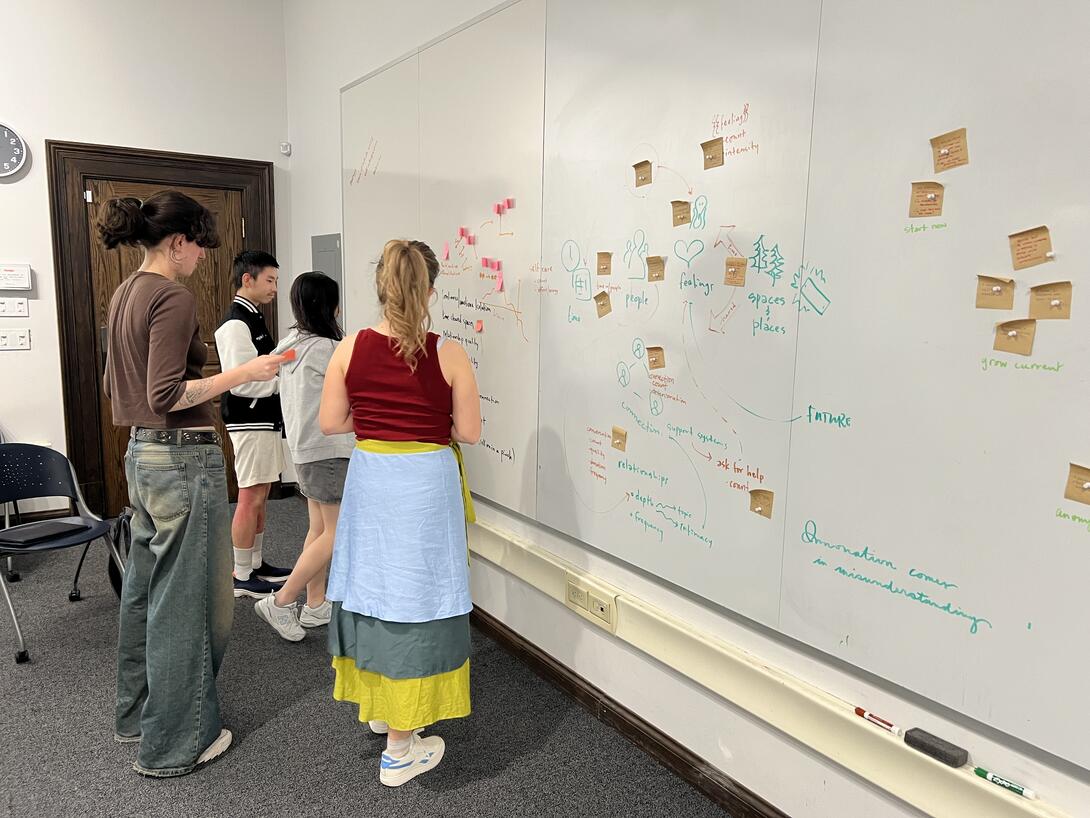Looking Back at the First Year of Joseph Ballay Center for Design Fusion Courses

The 2024-2025 academic year marked the first full year of courses from the Joseph Ballay Center for Design Fusion (JBCDF). The JBCDF, founded through an endowment from Professor Emeritus Joseph Ballay and his wife Sue, establishes a formal presence of design expertise and outreach at Carnegie Mellon University and creates a new outlet for the School of Design to advance its distinct approaches to problem-solving, interdisciplinary collaboration, and curricular innovation.
“The range of courses we offered this past year have demonstrated an excitement for the topics and for the opportunity for students to work across disciplines, challenge assumptions, and develop new ways of thinking that reflect the evolving role of design in shaping meaningful inquiry and impact,” said Professor Mark Baskinger, Director of the JBCDF.
One of the key components of the JBCDF are half semester courses that aim to provide new and exciting opportunities for CMU students to work in collaborative and creative ways. This year, students had the opportunity to take part in 5 unique courses designed to push boundaries, share knowledge, and fuse disciplines.
Bugs & Bioinspiration
How do insects build complex and efficient mechanical structures that rival human technology? What is the basic insect toolkit, and how have beetles adapted it to create glowing light, fire detectors, explosive weaponry, and color-changing armor? In Bugs & Bioinspiration, taught by Dr. Ainsley Seago, Associate Curator of Invertebrate Zoology at the Carnegie Museum of Natural History, students had the opportunity to explore these questions and examine the world’s most remarkable bugs up close, with specimens from the Carnegie Museum of Natural History.
“I love my work as a curator at the Carnegie Museum of Natural History, but it doesn't have as many opportunities as I would like for teaching,” said Seago. “I was thrilled to have a chance to design and teach my ‘dream course’ at CMU, and the students seem to have enjoyed it as well. The thing that makes this my dream course is the chance to synthesize 20 years of experience at the intersection of entomology, biomechanics, evolution, and art into this mini course.”
Seago, who oversees a priceless collection of over 16 million insect specimens at the Carnegie Museum of Natural History, brings from her experiences in the field of biomechanics, an area closely tied to robotics and material science.
“I like to think of it as a close study of the critical link between evolved solutions and bio-inspired design.”
Bugs & Bioinspiration is open to all students but might be of particular interest to students interested in mechanical engineering, materials science, or industrial design.
“There's plenty of inspiration here for fashion, architecture, and art,” added Seago. “I engage with them by making connections between insect solutions and human design challenges, also by showing them a large number of extremely cool bugs.”
Comics, Cybernetics and Dynamics of Change
In Comics, Cybernetics and Dynamics of Change, students explore the art of comics, cartooning and graphic novels in conjunction with the science of cybernetics—the transdisciplinary study of communications and control systems. The class lets students discover how visual storytelling, continuous feedback loops and behavioral economics can help people, individually and collectively, become agents of change in pursuit of goodness, beauty and truth.
“Twenty-five years ago I saw a keynote speech delivered by the renowned comics theorist, Scott McCloud, author of the books Understanding Comics and Making Comics,” said Bill Lucas, instructor of Comics, Cybernetics and Dynamics of Change. “His talk turned me on to the power of sequential artwork in conjunction with the disciplines of design, science and many other domains. Shortly thereafter, I discovered the transdisciplinary notion of cybernetics. All of those concepts have been percolating within me ever since.”
“This half semester mini-course provided the perfect opportunity for me to share my accumulated knowledge, learn more and promote positive change.”
Lucas, who is the chief architect of LUMA Institute's System of Innovation and co-author of Innovating for People: Handbook of Human-Centered Design Methods, integrates the “LUMA Principle” into the course. “The Luma Principle” calls for hyper-intentionality in the cybernetic practices of looking carefully, understanding deeply, making resourcefully and then adapting accordingly.
“This class is primarily for folks with abundant curiosity, and an inclination toward visual thinking,” added Lucas. “We spend the first half of the course conducting a series of hands-on visualization exercises. We also hear from an assortment of guest speakers. The second half of the course is devoted to the creation of a short comic book, or storyboards for an anime, or a graphic novella.”
Work by Ally Wen
Creative Concepting
In Creative Concepting, students explore what distinguishes good ideas from great ideas and develop skills for ideating, developing, and visualizing a compelling concept that resonates with clients - in an agency-like environment. The course is taught by designer Hayden Smith, an alumnus of the School of Design (BFA ’15) who has led integrated design teams across a variety of tech, automotive, and product sectors.
“I wanted to create a class that would help design students (and non-designers) hone their skills for developing and communicating ideas in a professional setting,” explained Smith. “For many students, the transition to professional work can be challenging and my hope is that this course eases that transition by sharing some real-world, practical advice.”

Creative Concepting, which will inevitably resonate with students nearing the end of their college journey, talks about professional work and starting one's career. A large portion of the course is structured around Smith’s real life professional journey from CMU to his current potion at Netflix as Creative Lead for one of Netflix's Events & Experiences teams.
“A good portion of the course is structured around my personal journey and experience,” said Smith. “I try to share an honest look at my own struggles and successes and pass along the lessons that proved most valuable to me when I was first starting my career.”
“In a sense, I'm trying to craft the course that past-me would have loved to take while I was a student.”
Designing for Presence
The discipline of design is motivated by a drive to make things better. It can be very difficult, however, to maintain a genuine engagement required to address the biggest challenges we face, when our personal, social, civic, economic and environmental anxieties take so much of our energy. How can we sustainably apply our creative problem solving when we regularly feel overwhelmed? Designing for Presence helps students nurture themselves and their connections as part of our practice of improving the world. Taught by Shaun Moon, who was most recently a Vice President of Product & Design at a leading education technology company, through a combination of readings, seminar discussion, mindfulness practices and a collaborative project, students will simultaneously fortify themselves, cultivate empathy toward others, and explore practical design interventions to a real issue affecting the local community.
"In 2024 I was participating in a program designed to empower people interested in 'The Art of Saving The Planet'," said Moon. "One of the fundamental concepts of this program is that our ability to change the world for good depends on cultivating clarity and awareness around our own goodness. This echoes an idea offered in a 1913 essay by Mahatma Gandhi when he said, 'We but mirror the world. All the tendencies present in the outer world are to be found in the world of our body. If we could change ourselves, the tendencies in the world would also change.' This felt like an invitation to reconsider 'design for change'—such as design for behavior change, systems change, or social change. Our long-standing framing of this sort of design is primarily as an intervention made external to those working on creative change."
"It’s worth exploring how a better understanding of oneself can differently illuminate paths to more lasting and sustained change."

Designing for Presence is an opportunity for anyone who wants to explore how to apply creativity to making life on Earth better in ways that benefit all. In this class, students will use practices of mindfulness to cultivate stability and freshness. Students also learn how to understand and care for themselves better in order to sustainably apply their efforts and avoid “burnout”.
"In this class, each of us agree to do our best to practice the attitudinal factors implemented by Jon Kabat-Zinn at the University of Massachusetts Hospital’s Mindfulness-Based Stress Reduction clinic," added Moon. "This helps us create and maintain an environment where divergent, non-judgmental thinking is encouraged, first in how we understand and talk about ourselves, and then in our design practices such as problem framing and creative exploration."
Patterns in Nature
Natural patterns have fascinated humans for thousands of years. In Patterns in Nature, students explore the diversity of insect visual design, from super-sneaky camouflage to the loudest warning signals; learn why patterns occur in nature and how form and function intersect in insects. This course, also taught by Dr. Ainsley Seago, has students use hands-on, up-close examination of museum specimens to study and illustrate their own original bio-inspired artwork.
“I've noticed tremendous interest in insect imagery and scientific illustration amongst 18-24 year old students, but there are very few courses available to fill this niche,” said Seago. “This course invites students to spend time doing very close (microscope-assisted) studies of insect specimens, but diverges from the typical technical illustration approach by focusing on color and pattern instead of perfectly symmetrical details.”
Seago, who has spent her career communicating research and other scientific content to audiences from kindergarten to the Australian Parliament, spends each week giving one in-depth lecture on a particular topic, plus one two-hour studio session in which students are charged with producing a full-color, large-scale reproduction of an insect color pattern in colored pencil. The final result is a series of portfolio-worthy illustrations and (in the aggregate) a novel perspective on the beauty and diversity of insect morphology.
“I've noticed that biomechanics and visual ecology research on insects always seems to attract interest across age and experience levels, and this course is a fantastic opportunity to synthesize everything I love about those topics while also introducing art-focused students to advanced biology concepts."
“The courses we offer through the Center for Design Fusion explore topics that attract a diverse range of academic backgrounds,” said Baskinger. “Our courses are designed around instructor expertise and offer platforms for interdisciplinary engagement and thoughtful exploration beyond traditional academic boundaries.”
“As the Center matures, our areas of inquiry will also evolve—but design remains the unifying catalyst, offering a shared lens through which diverse disciplines can converge, question, and productively engage with the world.”
For more information about current and future courses at the Joseph Ballay Center for Design Fusion